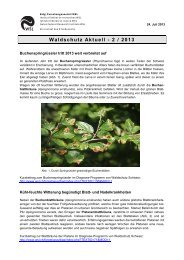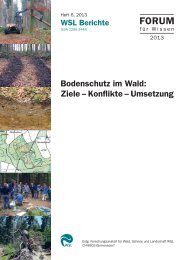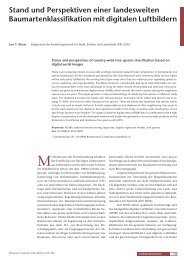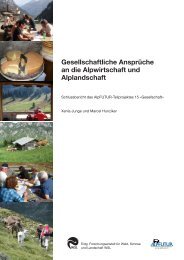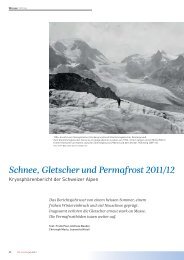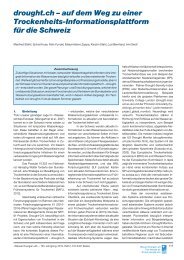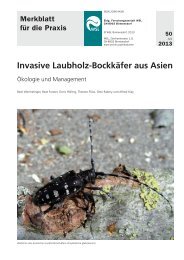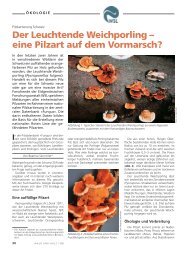Ecology and management of the spruce bark beetle Ips ... - WSL
Ecology and management of the spruce bark beetle Ips ... - WSL
Ecology and management of the spruce bark beetle Ips ... - WSL
You also want an ePaper? Increase the reach of your titles
YUMPU automatically turns print PDFs into web optimized ePapers that Google loves.
sanitation felling <strong>of</strong> infested trees, <strong>and</strong> <strong>the</strong> installation<br />
<strong>of</strong> trapping devices.<br />
10.1. Salvage<br />
Salvage in this context involves <strong>the</strong> harvesting <strong>of</strong><br />
windthrown timber, i.e. <strong>the</strong> preventive removal <strong>of</strong><br />
breeding substrates, as well as <strong>the</strong> sanitation felling<br />
<strong>of</strong> infested st<strong>and</strong>ing trees. Timely removal <strong>of</strong> windthrown<br />
timber is an important factor in <strong>the</strong> integrated<br />
<strong>management</strong> <strong>of</strong> I. typographus. Spruce logs should, if<br />
possible, be removed from <strong>the</strong> windthrows before<br />
following midsummer after <strong>the</strong> windthrow (Göthlin<br />
et al., 2000). A Danish study (Wichmann <strong>and</strong> Ravn,<br />
2001) showed that <strong>the</strong> density <strong>of</strong> attacks <strong>of</strong> st<strong>and</strong>ing<br />
trees around a windthrow area was least when <strong>the</strong><br />
timber was harvested between <strong>the</strong> infestation <strong>of</strong> <strong>the</strong><br />
logs after <strong>the</strong> spring flight <strong>and</strong> <strong>the</strong> emergence <strong>of</strong> <strong>the</strong><br />
new generation. The logs acted <strong>the</strong>n as trap trees, <strong>and</strong><br />
<strong>the</strong> resulting <strong>bark</strong> <strong>beetle</strong> progeny were killed. However,<br />
this is <strong>of</strong>ten too short a time span for a complete<br />
clearing <strong>of</strong> large windthrows. On-site de<strong>bark</strong>ing,<br />
which is a potential alternative, is hardly less timeconsuming<br />
<strong>and</strong> elaborate.<br />
Sanitation felling <strong>of</strong> infested trees is <strong>the</strong> most<br />
widespread measure to defeat I. typographus. This<br />
procedure is effective provided that (a) <strong>the</strong> trees are cut<br />
before <strong>the</strong> adult <strong>beetle</strong>s emerge; (b) <strong>the</strong> logs are<br />
de<strong>bark</strong>ed before storing in or near <strong>the</strong> forest or alternatively<br />
removed from <strong>the</strong> forest; <strong>and</strong> (c) <strong>the</strong> brood is<br />
disposed <strong>of</strong> in some appropriate way if <strong>the</strong>re are<br />
teneral <strong>beetle</strong>s present in <strong>the</strong> <strong>bark</strong>. This can be done<br />
by burning or chipping. With de<strong>bark</strong>ing machines, <strong>the</strong><br />
mortality <strong>of</strong> <strong>beetle</strong>s was found to be 93%. At high<br />
densities, this is considered to be still too low (Dubbel,<br />
1993).<br />
10.2. Trapping<br />
Pheromone traps are used as surrogates for trap<br />
trees. A key component <strong>of</strong> <strong>the</strong> pheromone lures is<br />
cis-verbenol (e.g. Jakus <strong>and</strong> Blazenec, 2002). The<br />
number <strong>of</strong> <strong>bark</strong> <strong>beetle</strong>s caught in pheromone traps<br />
very much depends on environmental <strong>and</strong> local<br />
conditions, such as temperature, exposition, sun<br />
exposure, <strong>and</strong> competition from nearby woody debris,<br />
slash, log stacks, windthrows, <strong>and</strong> susceptible<br />
trees (Lobinger, 1995). Traps exposed to <strong>the</strong> south,<br />
B. Wermelinger / Forest <strong>Ecology</strong> <strong>and</strong> Management 202 (2004) 67–82 75<br />
for example, were found to catch four times more I.<br />
typographus than those exposed to <strong>the</strong> north (Lobinger<br />
<strong>and</strong> Skatulla, 1996). Yearly catches could be<br />
correlated with <strong>the</strong> previous year’s temperaturesin<br />
May <strong>and</strong> June (Bakke, 1992). Most authors question<br />
<strong>the</strong> efficiency <strong>of</strong> pheromone traps as a measure for<br />
reducing <strong>bark</strong> <strong>beetle</strong> populations (Dimitri et al.,<br />
1992; Lobinger <strong>and</strong> Skatulla, 1996; Wichmann<br />
<strong>and</strong> Ravn, 2001). It has been calculated that only<br />
up to 10% <strong>of</strong> a population are caught with high trap<br />
densities (Weslien <strong>and</strong> Lindelöw, 1990; Lobinger<br />
<strong>and</strong> Skatulla, 1996). In one study 24 traps per hectare<br />
caught only an estimated 3% <strong>of</strong> <strong>the</strong> population<br />
(Lobinger <strong>and</strong> Skatulla, 1996). A total <strong>of</strong> 270,000<br />
trapswereusedduringanoutbreakinaSwedish<br />
province, but <strong>the</strong> breakdown <strong>of</strong> I. typographus in <strong>the</strong><br />
early 80’s was not attributed to this measure<br />
(Weslien, 1992a). Wichmann <strong>and</strong> Ravn (2001) found<br />
no correlation between trap catches <strong>and</strong> <strong>the</strong> density<br />
<strong>of</strong> tree attack around <strong>the</strong> traps, in contrast to earlier<br />
findings by Weslien et al. (1989). High trap catches<br />
did not necessarily correlate with high infestations,<br />
but low catches usually meant that little damage<br />
would occur (Weslien, 1992b; Lindelöw <strong>and</strong> Schroeder,<br />
2001).<br />
Traps are more <strong>of</strong>ten used to prevent attacks on<br />
living trees than to diminish I. typographus populations.<br />
This approach is <strong>of</strong>ten regarded a reasonable<br />
protection measure (Niemeyer et al., 1990; Dubbel et<br />
al., 1995; Jakus, 2001), although it involves considerable<br />
effort (Dimitri et al., 1992; Jakus, 1998a). Jakus<br />
(1998a) reported that an infestation front came to a<br />
st<strong>and</strong>still after one year when a two-row barrier <strong>of</strong><br />
pheromone traps was used. Unfortunately, <strong>the</strong>re was<br />
no simultaneous control treatment in this study. Trap<br />
trees, which were used more <strong>of</strong>ten before pheromones<br />
became commercially available, proved to be up to 14<br />
times more efficient in trapping <strong>beetle</strong>s than artificial<br />
traps (Drumont et al., 1992). In Belgium living trap<br />
trees baited with pheromones <strong>and</strong> treated with insecticides<br />
are still common. This kind <strong>of</strong> trap tree caught<br />
up to 30 times more <strong>beetle</strong>s than <strong>the</strong> widespread<br />
Theyson 1 trap (Raty et al., 1995), especially when<br />
<strong>the</strong> bait was protected from <strong>the</strong> sun. Extensive application<br />
<strong>of</strong> trap trees has also been reported to protect<br />
windfalls, with <strong>the</strong> number <strong>of</strong> trap trees being dependent<br />
on <strong>the</strong> previous year’s number <strong>of</strong> attacked trees<br />
(Grégoire et al., 1997).



